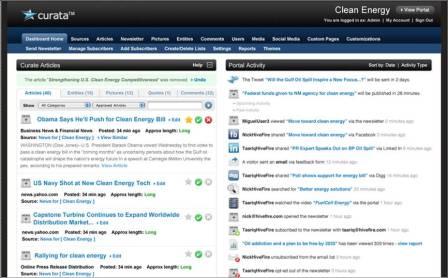HiveFire's Curata Platform for B2B Content Curation
Streamlining Multi-Channel Content Curation for B2B Marketers
Many of the enterprise content curation platforms found their first market with online publishers, who typically have a primary focus on real-time news and large IT departments supporting the online operation. By contrast, Curata by HiveFire, which launched a year ago as a content curation platform for B2B marketers, requires no IT support. Curata offers solutions for both real-time news curation and for building thought leadership collections. Gain insight into Curata’s strengths and weaknesses as a content curation platform for B2B marketers.
NETTING IT OUT
HiveFire is on a mission to convert marketers skeptical about the value of content curation. Its platform, called Curata, supports that mission. In many ways, the Curata content curation platform sets the standard for ease of use, functionality, and self sufficiency in this emerging marketplace. Curata has strong technical underpinnings, strategic integration with related capabilities, and turnkey implementation. Moreover, it produces results for marketers.
Our assessment of the Curata platform shows suitability for all uses of content curation in marketing. It has several capabilities that make its use for lead nurturing particularly robust. Specifically, provision of multiple newsletters from which information consumers can choose topics of interest, flexibility for marketers to choose a template that reflects the look and feel they want to achieve, and the integrated blogging platform facilitate the marketer’s job of providing timely relevant content that builds trust and retains interest.
As with any system, there are opportunities for improvement. Among the most valuable to marketers would be those that enable site visitors to more clearly indicate their interests, such as through site personalization, and making that personalization data available to the marketing automation or CRM system.
OVERVIEW OF HIVEFIRE
Company Background
Pawan Deshpande and Kevin Chevalier, both with Masters of Engineering in Computer Science from MIT, founded HiveFire in 2007. They initially targeted consumer marketers and agencies with content curation services. But the founders quickly recognized the critical role of content marketing for B2B companies. They re-focused their efforts to help B2B marketers find, organize, and share timely, relevant content with customers and prospects, introducing Curata, a content curation platform for B2B marketers, in the spring of 2010.
HiveFire is privately funded and has grown to 15 employees. It targets marketers who want to build a thought leadership position for their company, draw search engine traffic, or just provide a stream of timely relevant content to nurture prospects through a buying cycle. HiveFire gives marketers control over the SaaS platform, so the IT department doesn’t need to be involved in configuration or changes. Curata focuses on making the marketer more productive. Curata’s B2B marketing customers spend, on average, only about 19 minutes a day on content curation using the Curata platform. The results they achieve vary depending on their objectives: saving time on tasks they had always performed, higher rankings for organic search, more relevant content for lead nurturing, and greater visibility with both traditional media and social media.
Today, just one year after the official launch of Curata, HiveFire’s major customers include Novell, Zeiss Meditech, The Kauffman Foundation, Thermo Fisher Scientific, Airvana, Cambridge Healthtech Institute, and the Western Massachusetts Economic Development Corporation.
Earlier this year, HiveFire initiated a channel partner program for consultants and agencies in marketing, public relations, search engine optimization, and search engine marketing. Currently, they have 10 channel partners. These partners use Curata’s content curation platform in services they provide for their B2B clients.
HiveFire maintains a curated site, www.contentcurationmarketing.com, that uses the Curata platform to curate content related to content curation. Consistent with the marketing strategy of building a reputation as a thought leader in the area of content curation, HiveFire includes relevant information on the topic, even when it focuses on a competitor’s offering. Deshpande, who serves as CEO of HiveFire, blogs frequently on the site, and his blog posts are often featured content.
PRODUCT OFFERING
Curata aggregates news, blogs, journals, photos, video, and tweets; organizes them for review and selection by the curator; enables incorporation of original content through blogging; distributes the curated content in a variety of ways; and tracks usage by information consumers. Curata is a software-as-a-service (SaaS) solution. Pricing starts at $1,000 per month (when pre-paid for a year) for each microsite. It currently offers a 30-day free trial. There are no fees for the consultative setup. Microsite styling customization packages and bulk volume email newsletter packages may also be purchased.
Aggregation and Filtering
Curation starts with customers identifying sources (URLs, RSS feeds, OPML 1 )), keywords, and categories and tags for content organization relevant to their objectives. The system continuously scans for the keywords in the content streams from the specified sources, aggregates that content, and then uses natural language processing and machine learning technologies to remove duplicates, cluster related content, weight stories according to how important the keywords are in the document, and automatically tag content for presentation in categories.
Categories automatically include people, organizations, and locations. Curators specify additional categories for organizing the content, and the software learns to place content into the appropriate categories and also suggests new tags. Curators can view statistics on the volume and quality of individual sources and analytics on individual pieces of content. They can adjust their keywords and sources based on this feedback.
Review and Selection
The curator reviews the aggregated and filtered content on a dashboard like the one shown in Illustration 1. From that dashboard, curators decide whether to approve, delete, or feature each article. They can click “view similar” to review related content. The dashboard displays the length of each article (e.g., short, long) to aid curators in making quick article choices when two articles cover similar topics.
Curata Dashboard
© 2011 HiveFire
Illustration 1. This dashboard shows how the curator reviews and selects content after aggregation and filtering. Note the options to feature (yellow star), approve (green check), delete (red x), edit, view, or view similar articles. The right hand column shows recent activity at the curated microsite.
In the same review, curators can modify, add, or delete any metadata associated with the content, including tags, categories, and pictures. Also, at this stage in the workflow, curators can review related content and decide which stories should be published to any of their segmented newsletters and social media channels (Twitter, Facebook, and LinkedIn). Photos are curated on a separate tab from articles so that the curator can quickly scan to eliminate any advertising banners and select the best photo if several are featured.
As mentioned earlier, HiveFire’s customers average about 19 minutes a day doing this review, selection, and distribution.
Multiple curators can simultaneously curate content. Curata’s user permissioning system enables an administrator to selectively grant or prohibit curatorial access to individual users. If needed, Curata can authenticate users based on IP addresses.
Sequencing of articles on the microsite is a combination of chronology and clustering of related content. There is no relevancy ranking, which sometimes leads curators to edit the date on a more relevant article in order to move it to the top of a chronological list. This can be misleading! Curators can also “feature” particular articles.
Contact Info:
HiveFire
Pawan Deshpande
CEO
Email: Pawan@HiveFire.com
Phone: 1.617.229.5544
www.getcurata.com
***ENDNOTE***
1) Outline Processor Markup Language (OPML) is an XML format for outlines that is commonly used to exchange lists of web feeds between web feed aggregators.
***ENDNOTE***
Sign in to download the full article
0 comments
Be the first one to comment.




